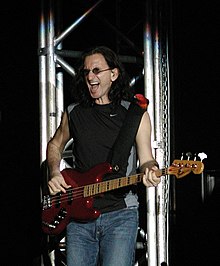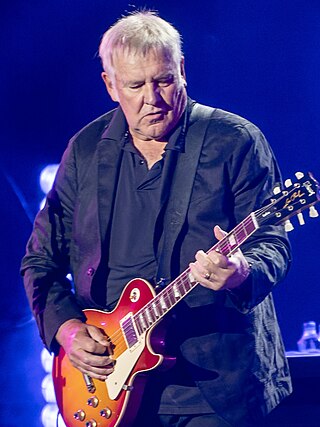
Aleksandar Živojinović, known professionally as Alex Lifeson, is a Canadian musician, best known as the guitarist for the rock band Rush. In 1968, Lifeson co-founded a band that would later become Rush, with drummer John Rutsey and bassist and lead vocalist Jeff Jones. Jones was replaced by Geddy Lee a month later, and Rutsey was replaced by Neil Peart in 1974, after which the lineup remained unchanged until the band's dissolution in 2018. Lifeson was the only member of Rush who stayed in the band throughout its entire existence, and he and Lee were the only members to appear on all of the band's albums.

Rush was a Canadian rock band formed in Toronto in 1968 that primarily comprised Geddy Lee, Alex Lifeson (guitar) and Neil Peart. The band's original line-up comprised Lifeson, drummer John Rutsey, and bassist and vocalist Jeff Jones, whom Lee immediately replaced. After Lee joined, the band went through a few line-up changes before arriving at its classic power trio line-up with the addition of Peart in July 1974, who replaced Rutsey four months after the release of their self-titled debut album; this line-up remained unchanged for the remainder of the band's career.

Signals is the ninth studio album by Canadian rock band Rush, released on September 9, 1982 by Anthem Records. After the release of their previous album, Moving Pictures, the band started to prepare material for a follow-up during soundchecks on their 1981 concert tour and during the mixing of their subsequent live album Exit...Stage Left. Signals demonstrates the group's continuing use of synthesizers, sequencers, and other electronic instrumentation. It is the last album produced by their longtime associate Terry Brown, who had worked with them since 1974.

2112 is the fourth studio album by Canadian rock band Rush, released in March 1976 by Mercury Records. It reached No. 5 in Canada and became the band's commercial breakthrough in America, peaking at No. 61.

A Farewell to Kings is the fifth studio album by Canadian rock band Rush, released on Anthem Records on August 29, 1977. The album reached No. 11 in Canada and marked a growth in the band's international fanbase, becoming their first Top 40 album in the US and the UK.

Rush is the debut studio album by Canadian rock band Rush. It was released on March 18, 1974, in Canada by Moon Records, the group's own label, before it was released internationally by Mercury Records later that year. Recorded five years after the band's formation, this first release shows much of the hard rock sound typical of many of the popular rock bands emerging earlier in the decade. Rush were fans of such bands as Led Zeppelin, Yes and Cream, and these influences can be heard in most of the songs on the album.

Fly by Night is the second studio album by the Canadian rock band Rush, released on February 14, 1975, by Mercury Records. It was the first Rush album to showcase elements of progressive rock for which the band has become known. It was also the first to feature lyricist and drummer Neil Peart, who replaced original drummer John Rutsey the previous summer just prior to the band's first North American tour. Peart took over as Rush's primary lyricist, and the abundance of fantastical and philosophical themes in his compositions contrasted greatly with the simpler hard rock of the band's debut album.

Caress of Steel is the third studio album by Canadian rock band Rush, released on September 24, 1975, by Mercury Records. It was recorded immediately after the band concluded touring in support of their previous album, Fly By Night, and marked a development in the group's sound, moving from the blues-based hard rock style of their debut towards progressive rock. Caress of Steel is considered Rush's first progressive rock album. Songs such as "The Necromancer" furthered Rush's advancement into narrative-driven, fantasy-based compositions, while "The Fountain of Lamneth" was their first prog-rock "epic" to span an entire side of vinyl. Other tracks like "Bastille Day" and "Lakeside Park" became staples of the band's live setlists.

Roll the Bones is the fourteenth studio album by Canadian rock band Rush, released September 3, 1991, on Anthem Records. The band began working on the album after a brief creative hiatus following the tour promoting their previous release, Presto (1989).

Moving Pictures is the eighth studio album by Canadian rock band Rush, released on February 12, 1981, by Anthem Records. After touring to support their previous album, Permanent Waves (1980), the band started to write and record new material in August 1980 with longtime co-producer Terry Brown. They continued to write songs with a more radio-friendly sound, featuring tighter and shorter song structures compared to their earlier albums.
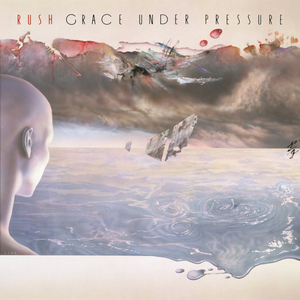
Grace Under Pressure is the tenth studio album by Canadian rock band Rush, released April 12, 1984, on Anthem Records. After touring for the band's previous album, Signals (1982), came to an end in mid-1983, Rush started work on a follow-up in August. The band had decided not to work with longtime producer Terry Brown, who had collaborated with Rush since 1974. The new material accentuated the group's change in direction towards a synthesizer-oriented sound like its previous album. After some difficulty finding a suitable producer who could commit, the album was recorded with Peter Henderson.

Exit... Stage Left is the second live album by the Canadian rock band Rush, released as a double album in October 1981 by Anthem Records. After touring in support of their eighth studio album Moving Pictures (1981), the band gathered recordings made over the previous two years and constructed a live release from them with producer Terry Brown. The album features recordings from June 1980 on their Permanent Waves (1980) tour, and from 1981 on their Moving Pictures tour.
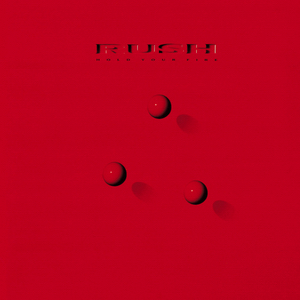
Hold Your Fire is the twelfth studio album by Canadian progressive rock band Rush, released on September 8, 1987. It was recorded at The Manor Studio in Oxfordshire, Ridge Farm Studio in Surrey, AIR Studios in Montserrat and McClear Place in Toronto. Hold Your Fire was the last Rush studio album released outside Canada by PolyGram/Mercury. 'Til Tuesday bassist and vocalist Aimee Mann contributed vocals to "Time Stand Still" and appeared in the Zbigniew Rybczyński-directed video.

Counterparts is the fifteenth studio album by Canadian rock band Rush, released October 19, 1993, on Anthem Records. After the band finished touring its previous album Roll the Bones (1991) in mid-1992, the members took a break before starting work on a follow-up.

Test for Echo is the sixteenth studio album by the Canadian rock band Rush, released on September 10, 1996, by Anthem Records. It was the final Rush album to be co-produced by Peter Collins. The band supported the album with a world tour in 1996 and 1997, after which they went on a five-year hiatus following the deaths of drummer Neil Peart's daughter and wife, and would not record again until 2001.

Different Stages is a live album by Canadian rock band Rush, released in 1998. The bulk of the first and second discs were recorded at the World Music Theatre in Tinley Park, Illinois, during the 1997 Test for Echo tour. Five other songs from various stops along the tour were included and three songs from the 1994 Counterparts tour. The third disc is taken from a performance at the Hammersmith Odeon in London during the A Farewell to Kings tour in 1978.

"Tom Sawyer" is a song by Canadian rock band Rush, originally released on their 1981 album Moving Pictures as its opener. The band's lead singer, bassist, and keyboardist, Geddy Lee, has referred to the track as the band's "defining piece ... from the early '80s".
"2112" is a song by the Canadian rock band Rush. It was released as a 20-minute song on their 1976 album of the same name and is the longest single song by the band. The overture and the first section, "The Temples of Syrinx", were released as a single. The song was adapted into a comic booklet, which used the lyrics of the song as lines for the characters and the narrations from the cover as intros.
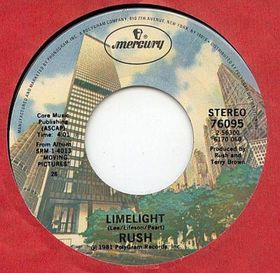
"Limelight" is a song by Canadian progressive rock band Rush. It first appeared on the 1981 album Moving Pictures. The song's lyrics were written by Neil Peart with music written by Geddy Lee and Alex Lifeson. "Limelight" expresses Peart's discomfort with Rush's success and the resulting attention from the public. The song paraphrases the opening lines of the "All the world's a stage" speech from William Shakespeare's play As You Like It. The band had previously used the phrase for its 1976 live album. The lyrics also refer to "the camera eye", the title of the song that follows on the Moving Pictures album.
Malignant Narcissism is an instrumental track from Rush's 2007 album Snakes & Arrows. "Malignant Narcissism" was nominated for a 2008 Grammy under the category of Best Rock Instrumental Performance, Rush's fifth nomination in said category. However, the song lost to Bruce Springsteen's "Once Upon a Time in the West" making it their fifth defeat in that category.


